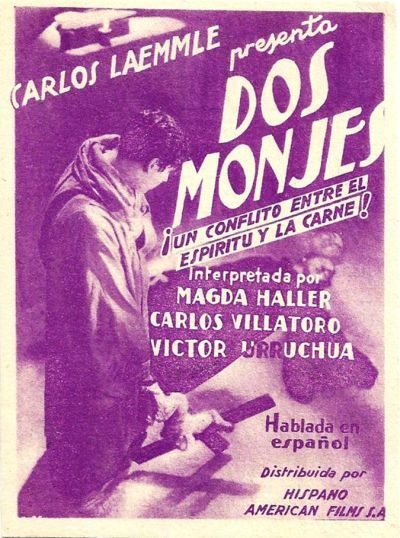
Rating: C+
Dir: Juan Bustillo Oro
Star: Víctor Urruchúa, Carlos Villatoro, Magda Haller, Beltrán de Heredia
a.k.a. Dos monjes
This has strong bookend sections and a film that is certainly ahead of its time in a number of ways. However, this isn’t able to conceal the basically banal nature of the central plot, a boring and tepid love triangle. We begin in a monastery where new monk Juan (Urruchúa) is asked to tend to the troubled Javier (Villatoro), only to be knocked unconscious with a crucifix for his pains. The prior (de Heredia) quizzes both men separately, to get to the bottom of things, and discovers there was previous history between them. Specifically, they were rivals for the love of Ana (Haller), before an incident in which she was shot dead.
Element ahead of its time, #1. We get to experience that story, first from Javier’s perspective, then Juan’s. This was sixteen years before Kurosawa’s Rashomon became the go-to example of an incident told from more than one perspective. Here, the approach is relatively rough in approach, yet Oro has some good flourishes. For example, when Juan tells his story, he is dressed in white as the hero, with the villainous Javier clad in black. When Javier describes his version, the costume tones are reversed. Unfortunately, it’s not enough to sustain a story which had difficulty keeping my attention once, never mind twice. It’s also surprisingly… gay for thirties Mexico. While I usually notice little and care less, at times I wondered if this love triangle should be tinted pink, shall we say.
 Element ahead of its time, #2. The visual style – especially, though not uniquely, around the monastery. Though it may not be ahead of its time so much as radically different. For if you showed me a still and told me this came out of Germany in the twenties, I’d have believed you, for this is, I guess, Mexican Expressionist cinema. Oro has a fine eye for it, especially towards the end when one of our protagonists goes a bit nuts, engaging in rampant, uncontrolled organ-playing, before hallucinating his fellow friars are monsters out to kill him (top). I’d have like to have seen more of this weirdness, along with the “possession in a monastery” angle, and less romantic melodrama.
Element ahead of its time, #2. The visual style – especially, though not uniquely, around the monastery. Though it may not be ahead of its time so much as radically different. For if you showed me a still and told me this came out of Germany in the twenties, I’d have believed you, for this is, I guess, Mexican Expressionist cinema. Oro has a fine eye for it, especially towards the end when one of our protagonists goes a bit nuts, engaging in rampant, uncontrolled organ-playing, before hallucinating his fellow friars are monsters out to kill him (top). I’d have like to have seen more of this weirdness, along with the “possession in a monastery” angle, and less romantic melodrama.
The latter does have its moments, such as before Javier and Ana are a thing, and he’s watching her interact with a suitor her family has brought in. This takes place entirely in silhouette, and is striking. But, between his song composition and consumption, Javier in particular is such a wuss as to resemble a pre-war, Hispanic version of Morrissey. Dios sabe que ahora soy miserable. So who shot Ana? The film never comes to any particular conclusion, and I suspect the director was considerably more interested in the journey than the destination. Though my money is on the loony one. Even at the time, the love story was considered “over-romantic and flamboyant.” Time has likely not done that aspect many favours.
